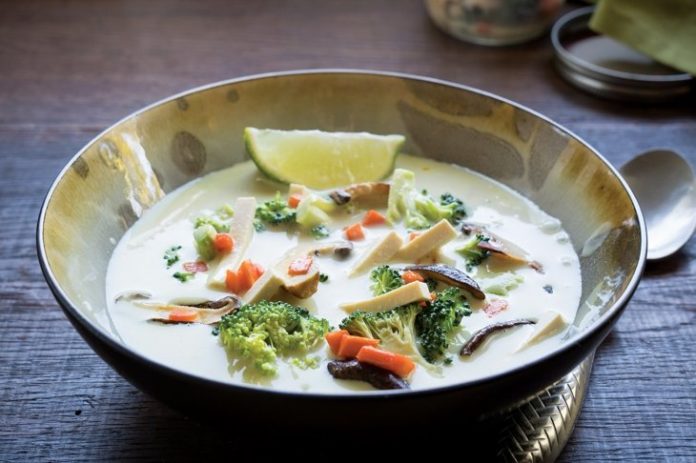
Steaming, boiling, brining, poaching, and sous vide cooking are all ways to use water, nature’s “blue gold,” in the kitchen. Each method brings something new to the table, turning raw ingredients into satisfying meals you’ll want to dive into.
You’re already cooking with water without even thinking about it. Water is one of the hardest working, least expensive ingredients you can engage in your everyday cooking practices, turning hard vegetables into melt-in-your-mouth delicacies, raw meat into tender morsels, and grains into digestible, delectable pearls.
Steaming, boiling, brining, poaching, and sous vide cooking are all ways we can manipulate water with the application of heat. Each method coaxes out different flavours and textures of our ingredients.
But before you turn on the tap, there are other ways to unlock water as an ingredient. For instance, straining the liquid from yogurt to produce yogurt water (whey) turns one ingredient into two. Here, whey is used to brine chicken, which ensures juiciness upon cooking. Brine from feta, pickles, and olives can all be used this way, too—you can save that water for infusing other dishes.
You’ll also find the method for sous vide cooking, which does require special gear. But the consistently delectable results, along with its versatility and compactness, make it splurge-worthy if you’re ready to go deep into cooking with water.
From simple to complex, comfort food to lightened-up lunches, you’ll be eager to dive into any one of these watered wonders.
Cooking with water recipes
Boiling: Thai Green Curry Coconut Soup

Brining: Whey-Brined Chicken with Avocado, Beets, Quinoa, and Greens

Poaching and steaming: Composed Squash, Turkey, and Greens in Lemon Broth

Sous vide: Tuna and Egg Niçoise with Roasted Baby Potatoes

Boiling: Cream of Cauliflower Soup with Curried Chickpea Croutons

Cooking with H2O 101
| How-to | Equipment | Best for | |
| poaching | Bring water to a simmer with aromatics such as mild fresh herbs, garlic, onion, ginger, lemongrass, and sesame oil. Reduce heat until only a few bubbles appear. Gently slide in food and poach until cooked through, testing vegetables with a knife, and meats, poultry, and fish with an instant-read thermometer. | pot and instant-read thermometer | lean meats, poultry, and fish (do not boil or this will toughen protein); tender but sturdy vegetables such as asparagus, radishes, and carrots |
| sous vide | Fill large pot with water and attach sous vide machine to side, or according to manufacturer’s directions. Preheat water before submerging food. Cook for manufacturer’s suggested time. | pot and sous vide machine | meat, poultry, fish, shellfish, sausages, eggs, and vegetables |
| boiling | Fill large pot with water and bring to a boil. Boil ingredient to recipe’s instructions. | pot | puréed soups, grains, pasta, and vegetables |
| steaming | Add steamer insert or basket to pot and fill with water (do not let water touch food). Add ingredients, cover, bring water to a boil, and reduce to medium-low. Steam until ingredients are cooked as desired, keeping an eye on water level to ensure it doesn’t dry out. Or, use steaming machine to steam to manufacturer’s directions. | pot and steamer basket or insert, or steaming machine | vegetables, rice, fish, poultry, shellfish, and dumplings |
| brining | Fill nonreactive bowl with whey (from straining yogurt) or water, and stir in salt until dissolved, plus aromatics such as bay leaves, citrus peels, garlic cloves, and onion. Add ingredient (usually poultry or pork), cover, and refrigerate for at least six hours or according to recipe’s instructions. Discard brine and dry ingredients before cooking. | nonreactive bowl and cover | meats, chicken, and turkey |
Too much moisture?
Salt, press, and drain the liquid out
| Why | How-to | |
| extra-firm tofu | Pressing water from extra-firm tofu makes it like a sponge to take up big, bold flavours, such as marinades and sauces. Removing excess water from tofu also makes it “meatier,” changing its texture from grainy to chewy. | Use a tofu press. If you don’t have one, place tofu on rimmed plate, top with cutting board and a stack of heavy books or a couple of cans (be careful, as this can be precarious!). Allow to drain for at least two hours, and preferably four. Drain liquid and proceed with recipe. For firm and extra-firm tofu varieties only. |
| eggplant | Salting eggplant extracts the bitter liquid from this sometimes-tough nightshade, priming it for use in your recipe to act as a flavour sponge, not a flavour spoiler. | Place wire rack over large rimmed baking sheet. Line sliced eggplant over wires and sprinkle with salt. Allow to sit for about 30 minutes, until eggplant has released a good amount of water and appears softened. Discard water. Proceed with recipe. |
| cucumber | Salting or simply draining cucumber extracts a large amount of liquid from the vegetable, drying it out for use in dips such as tzatziki and in yogurt-cucumber salads. | Grate or slice cucumber and place in fine-mesh sieve over bowl, sprinkle with salt (optional), and allow to drain for at least 30 minutes; gently press to hasten process. Keep water for use in cocktails, mocktails, dressings, dips, and smoothies. Proceed with recipe. |
| zucchini | Salting zucchini draws out excess moisture for a golden brown crust if roasting, grilling, frying (such as zucchini fritters), or turning into grain-free pizza crust. | Grate or slice zucchini and place in fine-mesh sieve over bowl, sprinkle with salt (optional), and allow to drain for at least 30 minutes; gently press to hasten process. Proceed with recipe. |









